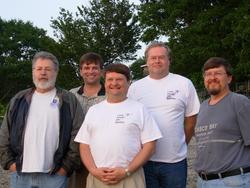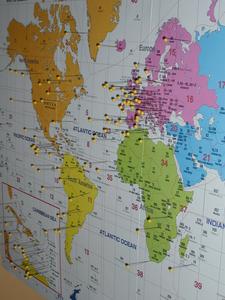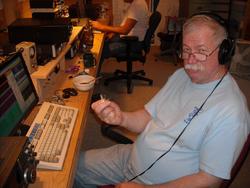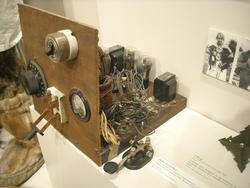 August 5, 2009 Editor: Ward Silver, NØAX | |||||
IN THIS ISSUE
NEW HF OPERATORS - THINGS TO DO The CW version of Worked All Europe (WAE) opens the fall contest season. Point your antennas across the Atlantic and give it a try, particularly the QTC feature. If you prefer phone, try the North American QSO Party for ten hours of low-power fun. BULLETINS There are no bulletins in this issue. BUSTED QSOS The Extended Double Zepp article referenced in the last issue was written by W2NB, not W2DB. (Thanks, Hank K8DD) CONTEST SUMMARY Complete information for all contests follows the Conversation section Aug 8-9
Aug 15-16
NEWS, PRESS RELEASES, AND GENERAL INTEREST WRTC-2010 is beginning to heat up! Now that the Russian version of the competition (Russian Radiosport Team Championship) is past, the organizers can turn their attention to next year's contest in Moscow. You can read the first press release at the WRTC-2010 Web site and look at photos of the RRTC competition, too! (Thanks, Harry RA3AUU)
The 2009 Mid-Atlantic VHF Conference, sponsored by the Packrats, will be held on September 26th in Plymouth Meeting, PA. Early bird registration closes on Aug 28 and papers are being accepted for publication until the end of next week on Aug 15th. The program includes everything from small station tips and tricks to optical transceivers, as well as a beginner's program. (Thanks, Paul W2PED) Thanks to Paul VE7BZ loaning me a copy, I can recommend "The World of Ham Radio, 1901-1950 - A Social History" by Richard A. Bartlett. Written in memory of Richard's brother Forrest Barlett, W6OWP (SK 2006), the book is a nice complement and extension of DeSoto's classic "200 Meters and Down". It fills in a lot of details about the development of the relay system by the ARRL and has a couple of really nice chapters on the amateur role in Arctic exploration. While Richard is not a ham (and there are a few oddly used bits of jargon that are but minor distractions), the writing rings true and makes for a good read. Fans of the quad can take heart - the classic Gem Quad has returned to the marketplace after several years of unavailability. VE5SI has taken up the product, fiberglass lattice spreaders and all. Having owned a Gem Quad myself, this is good news for fans of the concentric quad beam. (Thanks, Lee KØWA) High Sierra Antennas has added (and is adding) several new products, such as the nice lineup of canvas carry bags (I have several for carrying mobile whips and such) and a 10-pocket leather tool belt. There are lots of small items and monthly specials, as well as the Anderson PowerPole® connectors. (Thanks, Jim W6LG) This Technology Review story about keeping your email safe while traveling gave me some good ideas, rambling as I do. There's a never-ending series of cautions and techniques in these connected times.
There are lots of reports of not being able to pull in distant digital TV stations, now that the Big Switchover has been pulled. Hams are often expected to have "the answers" because we have those big antennas. ("I'll bet you can watch TV from Afghanistan, huh?") Krish W4VKU provided the link to the FCC database for TV stations with a lot of information on each. My usual referral is to the tvfool.com Web site that provides the information on a handy direction and strength compass. After a long run of providing logging software, Jim AD1C notes that Scientific Solutions has closed up shop and with it, the DXBase logging program. Ken K4ZW of the Potomac Valley Radio Club wrote to remind the readers that Frank W3LPL's Webinar "Design, Construction and Maintenance of Antennas and Towers for Long Term Reliability" is now posted. Click on the "Webinar" link. Up next is Dean Straw N6BV on August 5 at 8 PM EDT (August 6 - 00:00 UTC) with "Contest Antennas - DX or Domestic, What's Your Pleasure?" Then "Cycle 24" by Carl K9LA at August 19 at 8 PM EDT (August 20 - 00:00 UTC). Web Site of the Week - If you are looking up call sign addresses and printing mailing labels, you might find the WM7D call sign email service handy. Send an email to lookup@wm7d.net with a subject line of "callsign lookup" (use the word callsign, do not substitute the call you're trying to look up). The body of the message should be "lookup [call]" or "label [call]", where [call] is the call sign for which you want the information. (Thanks, John N2NC) WORD TO THE WISE DQ - disqualification - let's just say you don't want to go there. While comparatively rare in radiosport, making the DQ list is becoming less so. For example, the CQ WW committee lowered the boom on at least five (and maybe more) stations this year; four multi-ops and one single-op. Not only does this wipe out the year's effort, but in some cases suspends the contestant from future entries for a time. The operator(s) also become ineligible for the next WRTC. The story is covered on the radio-sport.net Web site (that appears to be down as this issue is being prepared) so stay tuned, as they say, for further details. SIGHTS AND SOUNDS Bruce AA5B noticed a potential solution to the no-sunspot problems on the Astronomy Picture Of the Day site - just make more suns! We've mentioned the High-Speed Morse competition before and here's a video of Fabian DJ1YFK loafing along at 150 wpm (not a typo). Fabian recommends the "Learn CW Online" program - maybe this would make learning Morse more attractive to someone more comfortable with online learning! (Thanks, John AE5X) From AMSAT's Weekly Bulletin ANS-207, you can take a gander at a replay of the Falcon-1 launch or the recent STS-127 launch (welcome home, folks!). After you're done with those, explore NASA's interactive Apollo 11 landing site. We take world-wide DX for granted nowadays, but it wasn't always so. What did it take to "cross the pond" way back when? Station 1BCG, built and operated by Paul Godley, was one of the first. In addition, Godley made a soggy expedition to Scotland in the dead of winter to listen for US amateurs. The 1BCG antenna was a modified T-top Marconi with a height of 70 feet, a flat-top of 100 feet, and an elevated radial system. ARRL members can see more in the February 1922 QST articles about the 1BCG station, his expedition to Scotland, and the results of this first successful DX contest. (Thanks, Frank W3LPL) Harry K7LAZ sends a link to this video of Denise Stoops, the first female operator at KPH, transmitting the closing message at the recent "Night of Nights" activity. Watching her flourishes at the paddle as the code blasts out was fun! The K1TTT Annual Picnic is always well-attended and fun, too! Events included "Guess the number of nuts and bolts in the jar" (Winner, KA1HSP), Guess the Mystery Loads (Winner, KK1L), "Scavenger Hunt" (Winner, AC2AC), "QSO Race" (Winner, K2XA), and a "Knot Tying Race" (Winner, N1FJ) Lots of photos to browse - maybe your club could try some of these ideas! RESULTS AND RECORDS The complete listing of high claimed scores for the CQ WPX Contest CW 2009 is now available. The purpose of publishing high claimed scores is to give entrants an opportunity to confirm that their entry has been submitted in the correct category and to get a first look at the competition. Please send any corrections or questions to k5zd@cqwpx.com. Logs are still welcome to cw@cqwpx.com. (Thanks, CQ WPX Director, Randy K5ZD) IOTA Contest Manager, Don G3XTT, notes that "a number of IOTA contest entrants have been having trouble mailing their logs. Unfortunately, after the rules were originally published, we had a change of Internet domain for the RSGB Contest Committee, so the earlier address no longer works. The correct address is iota.logs@rsgbcc.org." The RAC Canada Day committee has been having some issues with the claimed category of entry versus the actual contents of the log. When this issue is present, they are taking the content of the log as being reflective of the actual category of entry, so please check your entry class. (Thanks, Bart VE5CPU, RAC Canada Day Contest Manager) Results for the 2008 Canada Winter Contest have now been posted to the Radio Amateurs of Canada Web site and will be published in the next edition of TCA magazine. (Thanks, Sam VE5SF, RAC Canada Winter Contest Chairman) Contest Chair, Mal W5XX writes to let us all know that the results of the Mississippi QSO Party are posted! OPERATING TIP If your rig can clear the RIT via software control, it's not a bad idea to place that command in the "end of QSO" message (or following it). That restores your receive frequency to zero beat with every QSO. Otherwise, you might forget it's offset and miss a few QSOs. Don't ask me how I know this. TECHNICAL TOPICS AND INFORMATION Karl-Arne SMØAOM advises extreme caution when using voltmeters for measurements above 1000 volts, even if the meter has a high-votlage scale. "The internal and external flash-over distances are not sufficient to provide any safety margins, and hairline cracks, dust and dirt may create stray current leakage paths." The result is a significant shock hazard. If you have to use a meter above 1000 volts, Bill W6WRT notes that it's better to "make the connection to the meter with the power off, turn on the power, take the reading and turn off the power. In other words, don't touch the meter, the probes, or anything they are touching." Or use a high-voltage probe or high-value resistive divider designed for that use. Rudy N6LF reports, "I have recently completed a series of tests comparing the signal strength between a 40 meter vertical with 32, 1/4-wave radials in a complete circle to the same vertical with a sector missing from the radial system. This represents the case of placing a vertical near an obstruction such as a building." He reports a loss in signal strength in the no-radial directions. The results will be published in the Nov/Dec 2009 issue of QEX magazine. "In the meantime I suggest that placing a vertical against a building is probably a bad idea. If you have any other option, take it." Regarding the "dump power" from a four-square or other phased array, Tom K1KI suggests "routing that power back to the shack so you can monitor the power in real time - and be able to tell if you have a problem if you see changes from normal. That's particularly useful with more fragile four-squares made of wire elements that tend to attract tree branches and other annoyances."
There is a good tutorial -- "Fundamentals of Orthogonal Frequency Division Multiplexing (OFDM)" -- in the July 2009 edition of High Frequency Electronics by publisher Gary K9AY. Follow the links to the online PDF edition. As any rover can tell you, troubleshooting equipment in the dark on some lonely hilltop can be an exercise in frustration, especially in the heat of a contest! Les N1LF contributes this tip, use "Smart Glow Fuses" that light up when they're blown. He also uses clear fuse holders to make finding a blown fuse even easier. The fuses are sold at most automotive parts stores, Ace Hardware, Wal-Mart, and other retailers in sizes from 1 amp all the way up to 40 amps. For homebrew butterfly or trombone type variable capacitors, this handy Web site is just the ticket in helping you "roll your own". These capacitors avoid high current flow through potentially lossy rotating connections. (Thanks, Walter K5EST) The Honda Eu-series of portable generators is very popular, but the small gas tank is a bit of a drawback for extended use in portable operating. Scott N7SS found several solutions to the continuous fuel feed problem at Duration Power. These external tanks and feed lines might be adaptable to other small generators, as well. Troubleshooting RFI to a piece of home equipment? Here's a handy step-by-step list by Jim K9YC that may help you find the point-of-entry for RF in short order: You can use inexpensive corrugated plastic drain pipe as a cable conduit, but fish wires or "snake" might snag on the corrugations. Craig K1QX solves that problem by adding "a plastic golf "whiffle" ball on the end of his metal snake and it now merrily bounces its way thru the corrugated pipe. Herb KV4FZ responded to a TopBand reflector thread on folded monopoles by posting a link to a professional engineering report, "An Efficiency Comparison: AM/Medium Wave Series-Fed Vs. Skirt-Fed Radiators" by Rackley, Cox, Moser, and King, given at the NAB convention in 1996. From the Purpose of Research section, "The folded unipole is sometimes viewed as having beneficial characteristics beyond its utility for shunt feeding towers...[A] common belief is that a folded unipole produces significantly higher radiation than a series-fed tower of the same height...does not require a ground system...the current flowing in the ground system can be reduced...[and] have better bandwidth than series fed towers." Summarizing, Herb notes that the folded-unipole (folded-monopole) radiates no differently than the convention base-insulated series-fed tower, with the exception of the multiple conductors resulting in somewhat increased bandwidth. Gary K9GS wonders if anyone has ever tried using this resistance-soldering tool for plumbing to solder the body of PL-259s? It certainly looks like it could do the job! Got a noisy touch lamp that needs repair? My favorite tool for that kind of job is a precision sledgehammer, wielded smartly, but Don KD4E points us to the kinder, gentler ARRL Technical Information Service material. The Repair FAQ and DX Zone Web sites also have entries on the subject. How can you tell if two antennas are interacting such that they might cause pattern distortion? I pondered the question and decided that if there is meaningful interaction, you can also detect it as impedance variations as the antennas in question are turned. As a first attempt, attach an antenna analyze to the antenna under test (be wary of signals from nearby transmitters) then rotate the antenna with which you suspect interaction. If there is a significant amount of interaction, you'll see swings in SWR as the interacting antenna is rotated. The test is symmetric in that either of the two antennas can be rotated. If both are fixed, you would have to try modeling to see if there's a chance of significant interaction. If you decide to try plotting an antenna pattern, Mark K6UFO found these software tools, S Meter Lite and PolarPlot. Painting or sealing rods, pipes, and tubes is a pain, but Mark AA6DX suggests nearly filling PVC pipe closed on one end with the liquid to be applied, then adding the item to be coated, capping the tube, then shaking, tilting, and tipping the tube to slosh the coating around. "Radio Antenna Engineering", published in 1952 by Edmund Laport has a lot of excellent material on common antennas, materials, and technique. Long out-of-print and now out-of-copyright as well, lulu.com offers it as a free download or in print form for a fee. (Thanks, Paul W9AC) Technical Web Site of the Week - While watching (and listening to) the nimbocumulus clouds rolling in you might think about visiting the home page of The Lightning Protection Institute. There is also a Yahoogroup with a focus on lightning protection. It might be best to wait until the storm passes before logging on, though! (Thanks, Tom N4NW and Tom KD8DEG) CONVERSATION Contesting Under the Midnight Sun I had the distinct pleasure of being part of the W1AW/KL7 team during the IARU HF Championship. Graced with excellent HF conditions, we happily handed out our badly needed HQ multiplier to thousands of stations around the world. The operation could have been easily disrupted by the slightest solar sneeze, but the ionosphere and geomagnetic field cooperated nicely. Where did 10 meters suddenly come from, with 15 meters just as surprising? 20 meters was a 24-hour treat. Even at latitudes above 60 degrees North, with ol' Sol just closing one eye a little bit during the night, 40 and 80 meters were busy when skies were dark further south. 160 was a little surly and wanted to stay asleep, but we poked at it until a few QSOs were grudgingly allowed. As an upcoming QST article will detail, the full suite of stations were spread out across southeast Alaska. The SSB operators were located in Fairbanks, the Anchorage area, and on the Kenai Peninsula. The CW team was sequestered at the multi-op station of Rich KL7RA, near Nikiski and not far from the Cook Inlet. (Wild fires to the north kept conditions hazy enough that we weren't distracted by views of Mt Redoubt from Rich's deck.) The teams were all linked by WinTest logging software with full network connectivity - it was as if we were all just on different floors of the same house! When the shouting stopped, we'd amassed a claimed score just north of 5.5M points - a goal that was only mentioned in jest before the contest. Who knew that we'd get a dose of the best summer HF conditions in recent memory? That's a good reason to get on and stick with it - you just never know! At any rate, all of the operators that practiced and trained and worked on their stations to represent W1AW and the ARRL should be very proud of the results.
KL7 was also my "last state" for my "WOAS - Walked On All States" program, so the trip had a special meaning for me. Now I'm going to start my "OFAS - Operated From All States" odyssey, although it's nothing comparable to the "OFAZ - Operated From All Zones" achievement of N6AA and N6ZZ (SK). Totting up my travels, I think I have operated from 17 states and one Canadian province. This should keep me busy for a while -- it only took my seven years to log QSOs from all the Washington counties! Being honest about it, I guess I'm hooked on collecting things! How do you get to KL7, anyway? Sure, you can fly into Anchorage International, but maybe you'd rather sail up the Inside Passage along the Alaskan Panhandle and VE7 coasts. Cruise ships call at Seward and Homer on the Kenai Peninsula. Maybe you're a driver? The famed Alaskan-Canadian "Alcan" Highway is more driveable than ever and once in Anchorage, you can turn north to Denali, Fairbanks, and Barrow or south along the Sterling Highway to the Kenai. In the summer, you have the long, long, long days and in the winter, well, there's the aurora borealis to marvel at, even if it does tend to shut down the HF bands. Operating from somewhere far from home is always illuminating and provides a new appreciation of what the "other" guy or gal is experiencing. Pounding brass from KL7RA's QTH gave me a bit of Alaskan perspective to savor, just like the tasty reindeer sausage consumed with my over-easy's and hash-browns at Anchorage's famed White Spot Café. While you're in KL7, though, be sure to make a few QSOs - away from the solstices, you're never very far from gray line propagation. You might not be able to see Russia from Alaska, but the UA9's and UAØ's sure are loud! CONTESTS 5 August to 18 August An expanded, downloadable version of QST's Contest Corral in PDF format is available. Check the sponsor's Web site for information on operating time restrictions and other instructions. HF CONTESTS Worked All Europe--CW, from Aug 8, 0000Z to Aug 9, 2359Z. Bands (MHz): 3.5-28. Exchange: RST and serial (see Web for QTC rules). Logs due: 15 days. Rules SARTG WW RTTY Contest--Digital, from Aug 15, 0000Z to Aug 15, 0800Z and Aug 16, 0800Z to Aug 16, 1600Z. Bands (MHz): 3.5-28. Exchange: RST and serial. Logs due: Oct 7. Rules Dominican Independence Contest--Phone, from Aug 15, 0000Z to Aug 16, 0000Z. Bands (MHz): 3.5-14. Exchange: RS and serial. Logs due: Aug 30. Rules Russian District Award Contest--Phone,CW, from Aug 15, 0800Z to Aug 16, 0800Z. Bands (MHz): 1.8-28. Exchange: RS(T), serial or Russian district. Logs due: 30 days. Rules Keymen's Club of Japan Contest--CW, from Aug 15, 1200Z to Aug 16, 1200Z. Bands (MHz): 1.8-28, 50. Exchange: RST and JA pref/dist or continent. Logs due: Sep 20. Rules Silent Key Memorial Sprint--CW, from Aug 15, 1500Z to Aug 15, 1800Z. Bands (MHz): 1.8-28. Exchange: RST, S/P/C, QRP ARCI mbr nr or pwr. Logs due: Sep 15. Rules North American QSO Party--Phone, from Aug 15, 1800Z to Aug 16, 0600Z. Bands (MHz): 1.8-28. Exchange: Name and state. Logs due: 14 days. Rules New Jersey QSO Party--Phone,CW, from Aug 15, 2000Z to Aug 16, 0700Z and Aug 16, 1300Z to Aug 17, 0200Z. Bands (MHz): 1.8-28, 50,144. Exchange: Serial and NJ county or S/P/C. Logs due: Sep 14. Rules VHF+ CONTESTS ARRL 10 GHz and Up Contest--Phone,CW,Digital, from Aug 15, 6 AM to Aug 16, 12 AM. Bands (MHz): 10G+. Exchange: 6-character grid locator. Logs due: Oct 14. Rules Maryland-DC QSO Party--Phone,CW,Digital, from Aug 8, 1600Z to Aug 9, 0400Z and Aug 9, 1600Z to Aug 9, 2359Z. Bands (MHz): 1.8-28, 50-440, Frequencies: See Web site. Exchange: Maryland County/City or S/P/C. Logs due: Sep 14. Rules Keymen's Club of Japan Contest--CW, from Aug 15, 1200Z to Aug 16, 1200Z. Bands (MHz): 1.8-28, 50. Exchange: RST and JA pref/dist or continent. Logs due: Sep 20. Rules New Jersey QSO Party--Phone,CW, from Aug 15, 2000Z to Aug 16, 0700Z and Aug 16, 1300Z to Aug 17, 0200Z. Bands (MHz): 1.8-28, 50,144. Exchange: Serial and NJ county or S/P/C. Logs due: Sep 14. Rules LOG DUE DATES 5 August to 18 August August 6 - ARS Spartan Sprint, email logs to: spartansprint@yahoo.com, paper logs and diskettes to: (none). Rules August 10 - FISTS Summer Sprint, email logs to: wa1lad@cox.net, paper logs and diskettes to: Gil Woodside, WA1LAD, 30 Hilltop Ave., West Warwick, RI 02893-2825, USA. Rules August 10 - DL-DX RTTY Contest, email logs to: logs@drcg.de, paper logs and diskettes to: (none). Rules http://drcg.de/index.php?option=com_content&task=view&id=24&Itemid=36, August 10 - WLOTA Contest, email logs to: contest09@wlota.com, paper logs and diskettes to: WLH Award, 18 Allee Roch-Bihen, 44510 Le Pouliguen, France. Rules August 11 - IARU HF World Championship, email logs to: IARUHF@iaru.org, paper logs and diskettes to: IARU HF Championship, IARU International Secretariat, Box 310905, Newington, CT 06111, USA. Rules August 12 - ARCI Summer Homebrew Sprint, email logs to: contest@qrparci.org, paper logs and diskettes to: ARCI Summer Homebrew Sprint, c/o Jeff Hetherington, VA3JFF, 139 Elizabeth St. W., Welland, Ontario L3C 4M3, Canada. Rules August 15 - North American QSO Party, CW, email logs to: (see rules, web upload preferred), upload log at: http://www.ncjweb.com/naqplogsubmit.php, paper logs and diskettes to: Bruce Horn, WA7BNM, 4225 Farmdale Avenue, Studio City, CA 91604, USA. Rules August 16 - RSGB IOTA Contest, email logs to: iota.logs@rsgbcc.org, paper logs and diskettes to: RSGB IOTA Contest, Radio Society of Great Britain, 3 Abbey Court, Fraser Road, Priory Business Park, Bedford MK44 3WH, England. Rules August 17 - 10-10 Int. Summer Contest, SSB, email logs to: tentencontest@roadrunner.com, paper logs and diskettes to: Dan Morris, KZ3T, 131 Valencia Lane, Statesville, NC 28625, USA. Rules August 17 - SARL HF Phone Contest, email logs to: hfcontests@netactive.co.za, paper logs and diskettes to: Bloemfontein Radio Amateur Club, Box 12104, Brandhof, 9324, South Africa. Rules August 18 - RSGB RoPoCo 2, email logs to: ropoco2.logs@rsgbhfcc.org, paper logs and diskettes to: RSGB G3UFY, 77 Bensham Manor Road, Thornton Heath, Surrey CR7 7AF, England. Rules August 18 - CQC Great Colorado Gold Rush, email logs to: ki0rb@arrl.net, paper logs and diskettes to: (none). Rules ACKNOWLEDGEMENTS ARRL Contest Update wishes to acknowledge information from WA7BNM's Contest Calendar and SM3CER's Contest Calendar.
| |||||










